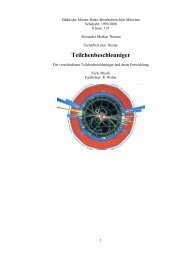The FEE Server Control Engine of the ALICE-TRD - Westfälische ...
The FEE Server Control Engine of the ALICE-TRD - Westfälische ...
The FEE Server Control Engine of the ALICE-TRD - Westfälische ...
You also want an ePaper? Increase the reach of your titles
YUMPU automatically turns print PDFs into web optimized ePapers that Google loves.
4 <strong>The</strong> <strong>ALICE</strong> Transition Radiation Detector<br />
≈ 800 mbar<br />
Supermodule<br />
P<br />
layer 5<br />
layer 0<br />
200 -<br />
300 mbar<br />
Main water<br />
tank<br />
Figure 4.5: Schematic view <strong>of</strong> <strong>the</strong> cooling system. <strong>The</strong> right pump removes air form <strong>the</strong> main<br />
water tank to keep <strong>the</strong> pressure level whereas <strong>the</strong> left pump circulates <strong>the</strong> cooling<br />
water.<br />
lines mounted on <strong>the</strong> walls <strong>of</strong> <strong>the</strong> supermodule. <strong>The</strong> cooling plant which circulates and<br />
cools <strong>the</strong> water is located outside <strong>the</strong> detector.<br />
Since <strong>the</strong> electronics is very water sensitive and <strong>the</strong> supermodules are not accessible<br />
once installed inside <strong>the</strong> <strong>ALICE</strong> detector, <strong>the</strong> cooling system is an under-pressure system<br />
(see figure 4.5). <strong>The</strong> main cooling water tank in <strong>the</strong> cooling plant is kept at a pressure<br />
level <strong>of</strong> 200 − 300 mbar by a pump which removes air out <strong>of</strong> <strong>the</strong> tank. A second pump<br />
circulates <strong>the</strong> water through <strong>the</strong> supermodules. Due to <strong>the</strong> significant low-pressure in<br />
<strong>the</strong> main tank <strong>the</strong> pressure level in all pipes and tubes <strong>of</strong> <strong>the</strong> cooling system is below<br />
atmospheric pressure.<br />
<strong>The</strong> main feature <strong>of</strong> this system is obvious. If somewhere in <strong>the</strong> supermodule a leak<br />
occurs air is drawn in <strong>the</strong> cooling tube instead <strong>of</strong> water leaking out. As long as <strong>the</strong><br />
amount <strong>of</strong> incoming air is smaller <strong>the</strong>n <strong>the</strong> amount <strong>of</strong> air <strong>the</strong> pump can remove from <strong>the</strong><br />
tank it is even possible to keep <strong>the</strong> whole system in normal operation.<br />
Figure 4.5 shows a schematic view <strong>of</strong> <strong>the</strong> cooling system and figure 4.6 (page 31) shows<br />
a readout chamber with cooling installed in a supermodule. Chapter 6 describes how <strong>the</strong><br />
proper cooling <strong>of</strong> <strong>the</strong> MCMs can be monitored.<br />
High voltage<br />
Each readout chamber requires two different high voltages (HV): a negative HV for <strong>the</strong><br />
drift region and a positive HV for <strong>the</strong> anode <strong>of</strong> <strong>the</strong> amplification region. For a complete<br />
supermoduel this results in 30 positive and 30 negative HVs. Since each voltage should<br />
be controable individually, 2 × 30 HV channels are required per supermodule.<br />
<strong>The</strong> high voltages are provided by modules produced by <strong>the</strong> company ISEG [ISE].<br />
Each HV module provides 32 HV channels with negative voltage (module type EDS 20<br />
025n_504) or positive voltage (module type EDS 20 025p_203). <strong>The</strong>refore each supermodule<br />
needs one EDS 20 025n_504 and one EDS 20 025p_203 HV module for operation,<br />
resulting in 18 × 2 HV modules for <strong>the</strong> complete <strong>TRD</strong>. <strong>The</strong> HV modules are located in<br />
P<br />
29







